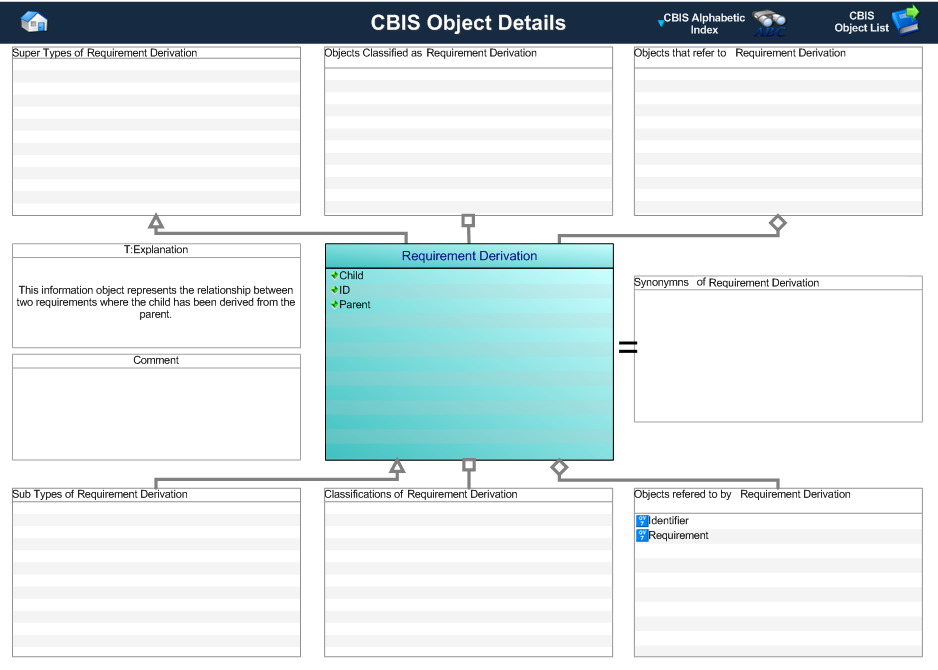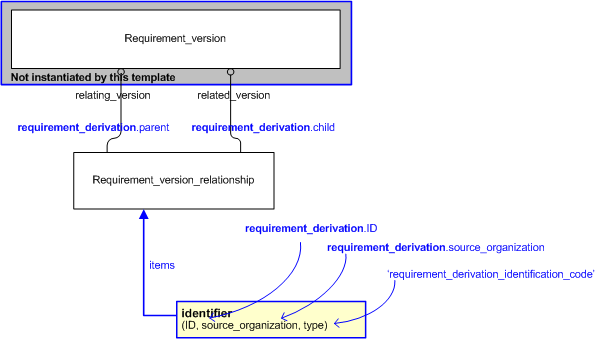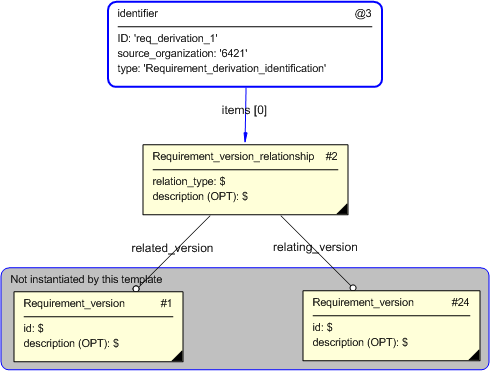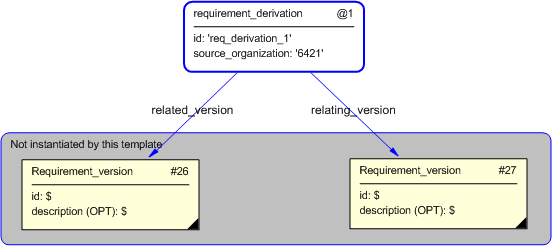Template:— requirement_derivation (reqt_deriv)
Context:— UK_Defence |
Date: 2009/04/17 11:42:30
Revision: 1.3
|
This section specifies the template requirement_derivation.
NOTE
The template has been defined in the context of
UK_Defence.
Refer to the business context for details of related templates.
NOTE
An explanation of a template and the associated instantiation path is
provided in the
Template overview
section.
This template describes how to represent the relationship between two requirements where the child has been derived from the
parent.
Requirement information is the means of identifying the relationship between two requirements where the child has been derived
from the parent.
This information object represents the information about the derivation of one requirement from another requirement.
Figure 1 — A MOOD Business Architect representation of the Business Object: requirement derivation
The attributes of the Requirement_derivation object are tabled below.
|
Attribute name
|
Attribute description
|
Attribute type
|
Optionality
|
| ID |
This is the identifier of the the requirement derivation. |
Identifier |
Mandatory |
| Identifier.id |
This is the value of the id attribute of the Identifier applied to the requirement derivation. |
Intrinsic |
Mandatory |
| Identifier.type |
This attribute is the type associated with the id of the Identifier given to the requirement derivation. This must be one
of the classes provided.
|
Organization_identification_code |
Mandatory |
| Identifier.source_organization |
This attribute is the value representing the source organization that provides the id of the Identifier given to the requirement
derivation. This value is assumed to be a type of Organization_identification_code.
|
Intrinsic |
Mandatory |
| Parent |
In a hierarchical relationship, this attribute is the requirement from which the child requirement has been derived.
In a sequential relationship, this represents the predecessor requirement.
|
Relationship to parent requirement |
Mandatory |
| Child |
In a heirarchical relationship, this attribute is the child requirement derived from the parent.
In a sequential relationship, this represents the successor requirement that replaces it.
|
Relationship to child requirement |
Mandatory |
Table 1 — Requirement_derivation attribute details
The EXPRESS-G diagram in
Figure
2
shows the templates and EXPRESS entities that are required
to represent the template
"requirement_derivation".
The text highlighted in blue shows the template parameters.
Figure 2 — An EXPRESS-G representation of the Information model for requirement_derivation
The graphic for the template to be used in other EXPRESS-G diagrams
is shown in Figure
3
below.
Figure 3 — The graphical representation of the requirement_derivation template
The following input parameters are defined for this template:
The identifier of the requirement derivation.
The organization or information system that created the associated identifier. Alternatively this could be set to /NULL when
Person or Information System is the source; see Identifier template characterizations.
The following reference parameters are defined for this template:
%^target = $requirement_derivation.requirement_derivation%
The instantiation path shown below specifies the entities that are to be
instantiated by the template.
A description of templates and the syntax for the instantiation path is
provided in the
Templates Help/Information section.
The following entities are instantiated with attributes as specified:
The instance diagram in Figure
4
shows an example of the EXPRESS entities and templates that are instantiated by the template:
/requirement_derivation(id='req_derivation_1', source_organization='6421', child='#1', parent='#24')/
(an illustration of the consolidated requirement_derivation template is shown in
Figure
5 below.)
Figure 4 — Entities instantiated by requirement_derivation template
The instance diagram in
Figure
5
shows the graphic symbol for the template that is to be
used in other instance diagrams. The example template is:
/requirement_derivation(id='req_derivation_1', source_organization='6421', child='#1', parent='#24')/
Figure 5 — Instantiation of requirement_derivation template
Characterizations
No common characterizations of the template
requirement_derivation
have been identified. However, the ISO 10303-239 EXPRESS model
may enable other assignments to the entities instantiated by the template.




